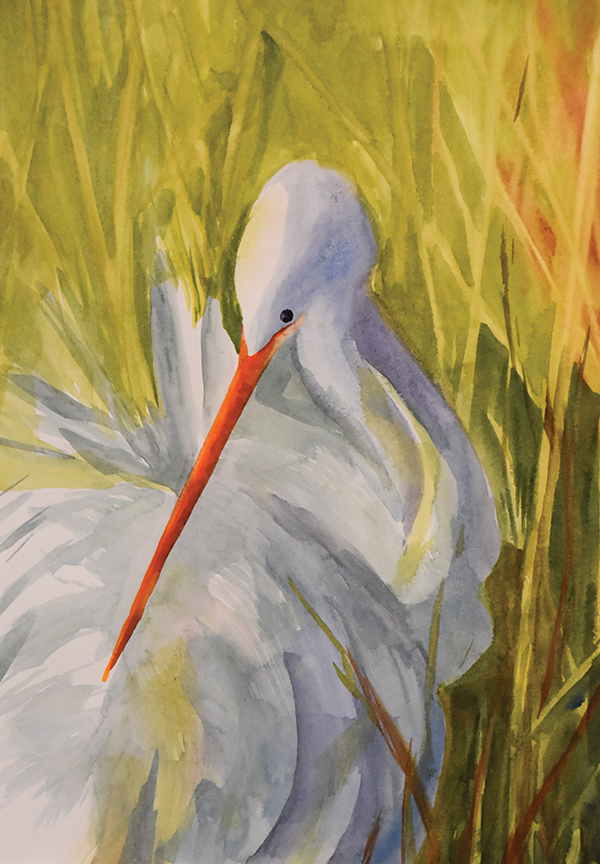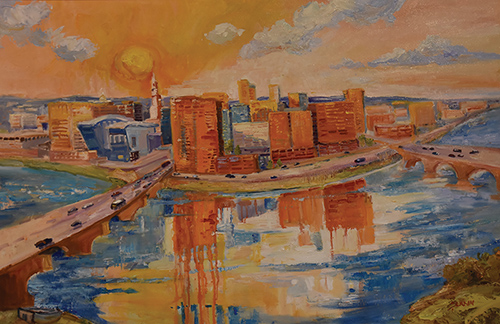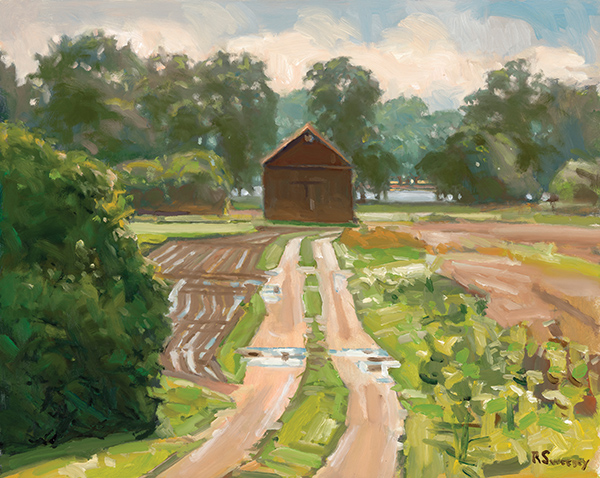Connecticut River Museum Presents
Art Exhibit
By Amy Trout
“Hands on the Land: Art & the Environment in the Connecticut River Valley” is a collaborative exhibit between the Connecticut River Museum and the Lyme Art Association.

“Snowy Egret” by Holly Hall.
The mission of the Connecticut River Museum is “to lead in the study, preservation, and celebration of the cultural and natural heritage of the River and its valley. By deepening our understanding of the River’s importance to past generations, the Museum will inspire the stewardship of future generations.” Our exhibits and programs typically use history or science to teach visitors about the changes that have affected our River Valley. “Hands on the Land,” however, uses art to interpret man’s impact on our environment.
Artists are keen observers of the natural world. The artists in this exhibit represent the beauty of wide-open scenic views but also examine the small and intimate parts of nature. They use their skills to inspect the natural world in micro—using a single specimen as their focus on the intricacies and connectedness of wildlife in our marshes. John Blair’s “Healthy Signs” zooms in on a dragonfly balanced on a blade of marsh grass. This care and attention to single out a small insect is the artist’s way of bringing attention to the importance of biodiversity to our marshes.

“Founders Memorial Park” by Karen Lipeika.
Other artwork also concentrate on a single creature. Holly Hall’s watercolor of a snowy egret and Candice Weigle-Spier’s collage “Salt Marsh” showcase the elegant bird whose presence in our marshes forces us to stop, pause—to stand still as they do—and to take in the majesty of the scene. This stillness allows us to participate in a communion between man and nature. Sharing such moments brings us to a state of contemplation and respect for nature.
The “Hands on the Land” topic naturally implies depictions of man-made structures in the River Valley. Bridges, old mills, factory buildings, and power plants are evidence of centuries of settlement and man’s attempt to conquer obstacles and harness river power. These depictions reinforce the fact that man has altered the landscape to fit each generation’s needs. Examples from the exhibit include Paul Loescher’s watercolor “Winter Sunlight Under the Baldwin Bridge,” which captures the scale of the massive gray concrete cavern under the Baldwin Bridge. Contrasting the cold light of the concrete is Blanche Serban’s “The City of the Golden Sun”—a canvas of golden light beaming off the city of Hartford, Connecticut, pulsating with vitality. The powerful image of a smokestack along the River, a symbol of pollution, is seen in Sarah Baskin’s watercolor “The Big Debate” and Rich Alexander’s canvas “Morning Beauty.” These images remind us that the Connecticut River was once heavily polluted and that there are still challenges ahead.

“The City of the Golden Sun” by Blanche Serban.
The fertile lands of the Connecticut River Valley have been farmed for centuries and agriculture remains an important, although less obvious, part of “man’s impact on the land.” Robert Sweeney’s oil painting of a 200-year-old barn in Whately, Massachusetts, features color and light illuminating the soil and water of the farmland that sits on the River’s banks. On the other hand, the muted tones of Keith Magner’s “On the Hunt” creates a quiet, timeless quality to the scene of a hunter and his dog walking through the fields of South Glastonbury, Connecticut. The view feels like we travelled back in time to the 19th century and glimpsed a rural idyll. These paintings bring us peace and reflection, but they also remind us that environmental concerns such as land clearing and old pesticide drainage can affect our rural landscapes.
People live, work, and play in the Connecticut River Valley. It’s no surprise that recreation would feature as one of man’s activities affecting our natural world. The bonds we create with nature are often the most enduring. Boating and fishing are part of the culture of the lower River Valley. Artist Sarah Stifler Lucas’s painting of fishermen silhouetted against the orange light of an approaching dusk is entitled “Fathers and Sons.” This multi-generational pastime ties us to a place and serves as a rite of passage. Maureen Page’s painting “Bass Day Ever” represents the pure joy of finding a quiet stretch of River and landing a whopping catch! Nature provides wonder, beauty, and bounty. As long as our waters and shores remain healthy, these activities can be passed on to future generations.
“Hands on the Land” is an exhibit filled with a variety of landscapes—marshes, forests, fields, and shorelines. Sometimes a serene view of nature’s beauty is the best environmental message, for it says all we need to know about what is at stake. Karen Lipeika painted the marshes viewed from “Founders Memorial Park” near the mouth of the River and Pam Carlson captured an “Upper CT River Inlet” hundreds of miles away, reinforcing the concept that the River is wild and ranging and consists of different habitats in need of protection.
Landmarks along the River such as the Connecticut River Museum’s Steamboat Dock, Haddam’s Shad Shack, and Portland’s quarries are remnants from the past still enticing the artist’s eye. The Museum and the quarries are examples of adaptive reuse of building or place no longer needed for its original purpose. There are many old buildings, dams, and intrusions lining the River that need attention and serve as a reminder of work yet to be done.
Artists know we share this River Valley with an abundance of creatures that we desperately need to protect to ensure a healthy environment. Ducks, osprey, shad, hawks, and turkeys emerge from the canvases around the gallery. There are two sculptures, Susan Van Winkle’s “Eagle Eye,” a majestic bronze eagle head, and Serena Bates’s “Survivor,” a ceramic seal whose body is crisscrossed with golden webbing from a fisherman’s net, representing species that have been victims of man’s careless acts.
As we face mounting threats from climate change and continued adaptations to our landscape, we look for new ways to engage people and spark discussions about these topics. The forty artists who participated in the “Hands on the Land” exhibit offer visions of the Connecticut River Valley that inspire us and perhaps give us a different perspective of our natural world and the changes brought by “man’s hands on the land.”
Amy Trout is the curator for the Connecticut River Museum in Essex, Connecticut.
Connecticut River Museum provided the article and photographs of the artwork to Estuary magazine for layout.

“Hands on the Land” is on exhibit from
March 18th through October 10th, 2021,
at the Connecticut River Museum, 67 Main
Street, Essex, Connecticut.
The Museum is open Tuesday through Sunday,
10 a.m. to 5 p.m. Admission is charged.
The exhibit travels to the Lyme Art Association,
90 Lyme Street, Old Lyme, Connecticut, from
November 19th, 2021, through January 2nd,
2022. All artwork is for sale.
◄ “Riverside Barn” by Robert Sweeney.

